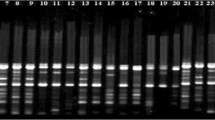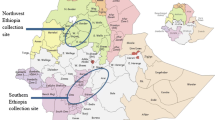Abstract
Sixty one persimmon (Diospyros kaki Thunb.) selections, including 17 Italian, 11 Spanish, 13 Japanese, six Korean, five Chinese, one Israeli, and eight of unknown origin, were evaluated for genetic differences by AFLP analysis. Relationships among cultivars were evaluated by UPGMA clustering, Neighbor Joining, and MultiDimensional Scaling. While similarities among groups were generally less than 0.60, both UPGMA and Neighbor Joining separated European and Asian cultivars. Spanish and Italian cultivars were not separated by any of the analyses, suggesting that they share a common gene pool, while Japanese, Chinese and Korean cultivars formed distinct clusters. Diversity within groups was greater than diversity between groups. Most cultivars were quite polymorphic (only 0.60–0.80 similarity between cultivars). In addition, the presence of several Japanese cultivars in the European group and a group of European cultivars nested between Chinese and Korean groups suggest that similar, but different progenitors were used in the development of the present European cultivars. ‘Kaki Tipo’ selections from different sources were clearly different by AFLP analysis, indicating that they are separate cultivars.



Similar content being viewed by others
References
Badenes M, Garces A, Romero C, Romero M, Clave J, Rovira M, Llacer G (2003) Genetic diversity of introduced and local Spanish persimmon cultivars revealed by RAPD markers. Genet Resour Crop Evol 50:579–585
Bellini E, Bellini C, Giordani E, Perria R, Paffetti D (2003) Genetic and morphological relationships between possible Italian and ancestral cultivars of persimmon. Acta Hort 601:192–197
Bellini E, Giordani E (2005) Germplasm and breeding of persimmon in Europe. In: Park YM, Kang SM (eds) Proceedings of 3rd International Symposium on Persimmon. Acta Hort 685:65–75
Doyle JJ and Doyle JL (1987) A rapid DNA isolation procedure for small quantities of fresh leaf tissue. Phytochemical Bulletin No. 19. The Phytochemical Section of the Botanical Society of America, Irvine, California, pp 11–15
FAO (2006) FAOSTAT Database. http://faostat.fao.org/
Kikuchi A (1948) Pomology, Part 1. Yokendo, Tokyo Japan, pp 347–400
Kim J, Rohlf FJ, Sokal RR (1993) The accuracy of phylogenetic estimation using the neighbor-joining method. Evolution 47:471–486
Nei M, Li WH (1979) Mathematical model for studying genetic variation in terms of restriction endonucleases. Proc Natl Acad Soc USA 76:5269–5273
Rohlf FJ (1998) NTSYS-PC Numerical taxonomy and multivariate analysis system, Version 2.0. Exeter Publications Setauket, New York
Swofford DL (1998) PAUP*: Phylogenetic analysis using parsimony. Version 4.0 beta10a. Sinauer Associates, Sunderland, MA
Yonemori K, Sugiura A, Yamada M (2000) Persimmon genetics and breeding. In: Janick J (ed) Plant breeding reviews, vol. 19, pp 191–225
Author information
Authors and Affiliations
Corresponding author
Rights and permissions
About this article
Cite this article
Yonemori, K., Honsho, C., Kitajima, A. et al. Relationship of European persimmon (Diospyros kaki Thunb.) cultivars to Asian cultivars, characterized using AFLPs. Genet Resour Crop Evol 55, 81–89 (2008). https://doi.org/10.1007/s10722-007-9216-7
Received:
Accepted:
Published:
Issue Date:
DOI: https://doi.org/10.1007/s10722-007-9216-7




